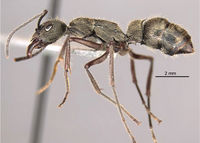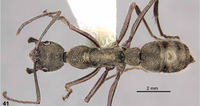Diacamma holzschuhi
| Diacamma holzschuhi | |
|---|---|

| |
| Scientific classification | |
| Kingdom: | Animalia |
| Phylum: | Arthropoda |
| Class: | Insecta |
| Order: | Hymenoptera |
| Family: | Formicidae |
| Subfamily: | Ponerinae |
| Tribe: | Ponerini |
| Genus: | Diacamma |
| Species: | D. holzschuhi |
| Binomial name | |
| Diacamma holzschuhi Laciny, Pal & Zettel, 2015 | |
Nothing is known about the biology of Diacamma holzschuhi.
| At a Glance | • Gamergate |
Identification
Laciny et al. (2015) - Relatively small species (TL 10.5–11.7 mm). Trunk black, without metallic shimmer. Mandibles and legs dark brown to black. Long setae abundant; fine pilosity sparse. Trunk coarsely striate from genae to gaster tergite 1. Head short, sides posteriorly of eye strongly convex. Posterior of head longitudinally striate until narrowly truncated hind margin; narrow margin ventrally terminating in short, acute teeth. Eyes moderately large. Clypeus entirely punctured, apex acute. Mandible with some strong punctures and with fine striation, in some specimens obliterate. Pronotum concentrically striate, but with some short transverse rugae in centre. Striation on propodeum oblique. Petiole very stout, its teeth moderately long; subpetiolar process shallowly concave between acute anterior and posterior corners. Gaster tergite 1 with semi-circular striation.
Diacamma holzschuhi is a coarsely sculptured species of the Diacamma rugosum species group. Within this group it can be recognized by the combination of absence of metallic lustre, short head (CI = 78–84), oblique rugae on the propodeum sides, and coarse, concentric rugae on gaster tergite 1. The eyes are relatively small, the head sides behind eyes shortly convex, and the occipital margin ends in a distinct tooth.
Superficially similar taxa from the area like D. “geometricum” var. longiceps from northern Vietnam and D. “rugosum” var. anceps from southern China (Hong Kong) and other areas differ considerably by long heads, large eyes, and horizontal rugae on the propodeum sides. Diacamma “ceylonense” var. orbiculatum from Laos (which is not closely related to Diacamma ceylonense), has a relatively short head and slightly oblique rugae on propodeum sides, but differs in the rugae on pronotum that are strictly concentrical around a point, by semi-elliptical rugae (longitudinally directed) on gaster tergite 1, and by dense pilosity.
Distribution
Northern Laos.
Distribution based on Regional Taxon Lists
Oriental Region: Laos (type locality).
Distribution based on AntMaps
Distribution based on AntWeb specimens
Check data from AntWeb
Countries Occupied
| Number of countries occupied by this species based on AntWiki Regional Taxon Lists. In general, fewer countries occupied indicates a narrower range, while more countries indicates a more widespread species. |

|
Estimated Abundance
| Relative abundance based on number of AntMaps records per species (this species within the purple bar). Fewer records (to the left) indicates a less abundant/encountered species while more records (to the right) indicates more abundant/encountered species. |

|
Biology
Castes
Nomenclature
The following information is derived from Barry Bolton's Online Catalogue of the Ants of the World.
- holzschuhi. Diacamma holzschuhi Laciny, Pal & Zettel, 2015: 115, figs. 40-43 (w.) LAOS.
Unless otherwise noted the text for the remainder of this section is reported from the publication that includes the original description.
Description
Worker
Laciny et al. (2015) - Holotype: TL 11.61; HW 1.99; HL 2.51; EL 0.52; SL 2.80; PH 1.54; PL 1.02; PW 1.18; SpD 0.49; SpL 0.37; WL 3.88; MTL 2.18. Indices: CI 79; SI 141; PI 66; SpDI 42; SpLI 32; EI 26. Measurements of paratypes (n = 10): TL 10.50–11.74; HW 1.89–2.09; HL 2.41–2.67; EL 0.50–0.57; SL 2.64–2.90; PH 1.46–1.61; PL 0.91–1.04; PW 1.10–1.26; SpD 0.46–0.59; SpL 0.31–0.40; WL 3.59–4.04; MTL 2.04–2.28. Indices: CI 78–84; SI 133–140; PI 61–66; SpDI 42–49; SpLI 29–34; EI 26–27.
Structures: Head relatively short; sides strongly convex behind moderately large eyes. Coarse rugae present from genae to gaster tergite 1. Posterior of eyes, longitudinal rugae reaching very narrow occipital margin. On ventral side of head occipital margin ending in a small, but sharp tooth. Clypeus entirely punctured, but shiny, strongly protruded into an approximately rectangular, sharp apex. Mandible with some strong punctures and with fine striation, in some specimens obliterate. Pronotum concentrically striate, with some short, transverse rugae in centre. Rugae on mesosoma sides oblique. Posterior face of propodeum separated from sides by distinct carinae. Petiole very stout, its teeth moderately long, with pronounced concavity between them; subpetiolar process with shallowly concave, densely pilose outline, in ventral aspect with paired medial carinae and short lateral carinae anteriorly, anterior and posterior corners acute. Gaster tergite 1 with coarse, transverse-concentric, semi-elliptical rugae; along posterior margin densely punctured. Gaster tergite 2 shiny, with very fine microsculpture that is reduced on disc in a few specimens; with delicate traces of a short longitudinal striation on sides of disc in two specimens.
Pilosity: Trunk and legs with numerous, long setae; standing setae on scape slightly shorter. Short appressed pilosity weakly developed, but denser on clypeus, mesonotum, meso- and metapleura, dorsal face of propodeum, posterior margins of pronotum and gaster tergite 1, and the other gastral tergites.
Colour: Trunk black, without metallic shimmer, but shiny. Very narrow hindmargins of gaster tergites and sternites yellowish brown. Mandibles and legs (except for black fore coxae) dark reddish brown or blackish.
Type Material
Holotype (worker, Naturhistorisches Museum Wien, Vienna, CASENT0915963), north-eastern Laos, Hua Phan Province, Ban Saleui, Phou Pan Mountains, 1300–1900 m a.s.l., N 20°12', E 104°01', 28.IV.2014, leg. Carolus Holzschuh. Paratypes: 23 workers (Herbert and S.V. Zettel, NHMW), same locality, with different collecting dates, 8–30.IV.2015, leg. Carolus Holzschuh.
Etymology
Kindly dedicated to Dr. Carolus Holzschuh who provided the specimens.
References
References based on Global Ant Biodiversity Informatics
- Jaitrong W., B. Guenard, E. P. Economo, N. Buddhakala, and S. Yamane. 2016. A checklist of known ant species of Laos (Hymenoptera: Formicidae). Asian Myrmecology 8: 1-32. DOI: 10.20362/am.008019

